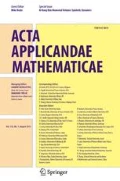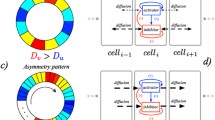Abstract
In this paper, we consider a model for the switching behaviour (determination) of a cell proposed by Meinhardt (1982) and observe that this two component system can create a pattern only in the presence of cross-diffusion. We also analyse the global behaviour of this model system by the Bendixson–Dulac criteria and Liapunov functional method.
Similar content being viewed by others
References
Auchmuty, J. F. G. and Nicolis, G.: Bifurcation analysis of nonlinear reaction diffusion equations — I: Evolution equations and the steady-state solutions, Bull. Math. Biol. 37 (1975), 323–365.
Auchmuty, J. F. G. and Nicolis, G.: Bifurcation analysis of nonlinear reaction diffusion equations — III: Chemical oscillations, Bull. Math. Biol. 38 (1976), 325–350.
Alimirantis, Y. and Papageorgiou, S.: Cross-diffusional effects on chemical and biological pattern formation, J. Theoret. Biol. 151 (1991), 289–311.
Babloyants, A. and Hiernaux, J.: Models for cell differentiation and generation of polarity in diffusion governed morphogenetic fields, Bull. Math. Biol. 37 (1975), 637–657.
Berding, C. and Haken, H.: Pattern formation in morphogenesis, J. Math. Biol. 14 (1982), 133–151.
Birkhoff, G. and Rota, G. C.: Ordinary Differential Equations, Ginn, Boston, 1982, p. 23.
Chattopadhyay, J., Tapaswi, P. K. and Mukherjee, D.: Formation of a regular dissipative structure: a bifurcation and nonlinear analysis, Biosystems 26 (1992), 211–222.
Chattopadhyay, J. and Tapaswi, P. K.: Order and disorder in biological systems through negative cross-diffusion of mitotic inhibitor — a mathematical model, Math. Comp. Modelling 17 (1993), 105–112.
Chattopadhyay, J. and Tapaswi, P. K.: Morphogenetic prepattern during embryonic development — a nonlinear analysis, Appl. Math. Lett. 5 (1992), 19–22.
Clark, C. W.: Mathematical Bioeconomics: The Optimal Managment of Renewable Resources, Wiley, New York, 1976.
Gierer, A. and Meinhardt, H.: Applications of a theory of biological pattern formation based on lateral inhibition, J. Cell. Sci. 15 (1974), 321–376.
Gierer, A. and Meinhardt, H.: A theory of biological pattern formation, Kybernetica 12 (1972), 30–39.
Granero, M. I., Porati, A. and Zanacca, D.: Bifurcation analysis of pattern formation in diffusion governed morphogenetic field, J. Math. Biol. 4 (1977), 21–27.
Haken, H. and Olbrich, H.: Analytical treatment of pattern formation in the Gierer-Meinhardt model of morphogenesis, J. Math. Biol. 6 (1978), 317–331.
Hsu, Sze-Bi, Waltman, P. and Wolkowicz, G. S. K.: Global analysis of a model of plasmid-bearing, plasmid-free competition in a chemostat, J. Math. Biol. 32 (1994), 731–742.
Hunding, A. and Sorensen, P. G.: Size adaptation of Turing prepatterns, J. Math. Biol. 26 (1988), 27–39.
Huppert, H. E. and Hallworth, M. A.: J. Phys. Chem. 88 (1984), 2902–2905.
Jorne, J.: Negative ionic cross-diffusion coefficient in electrolytic solution, J. Theoret. Biol. 55 (1975), 529–532.
Lefever, R. and Prigogine, I.: Symmetry breaking instabilities in dissipative system — II, J. Chem. Phys. 48 (1968), 1695–1700.
Levin, S. A. and Segel, L. A.: Pattern generation in space and aspect, SIAM Rev. 27 (1985), 45–67.
Martinez, H. M.: Morphogenesis and chemical dissipative structures: a computer simulation case study, J. Theoret. Biol. 36 (1972), 479–501.
McDougall, T. and Turner, J. S.: Influence of cross diffusion on finger double diffusive convection, Nature 299 (1982), 812–822.
Meinhardt, H.: Models of Biological Pattern Formation, Academic Press, London, New York, 1982.
Meinhardt, H.: Hierarchical inductions of cell states: a model for segmentation in Drosophila, J. Cell. Sci. Suppl. 4 (1986), 357–381.
Murray, J. D.: Lectures on Nonlinear Differential Equation Models in Biology, Oxford University Press, 1977.
Murray, J. D.: Mathematical Biology, Springer-Verlag, Heidelberg, 1989.
Murray, J. D.: Discussion: Turing's theory of morphogenesis — its influence on modelling biological pattern and form, Bull. Math. Biol. 52 (1990), 119–152.
Murray, J. D. and Oster, G. F.: Generation of biological pattern and form, IMA J. Math. Appl. Medic. Biol. 1 (1984), 51–75.
Murray, J. D. and Maini, P. K.: A new approach to the generation of pattern and form in embryology, Sci. Prog. Oxford 70 (1986), 539–553.
Nakamura, R.: The transport of histidine and methionine in rat brain slices, J. Biochem. 53 (1963), 314–332.
Nicolis, G. and Auchmuty, J. F. G.: Dissipative structures, Catastrophes and pattern formation: a bifurcation analysis, Proc. Natl. Acad. Sci., U.S.A. 71 (1974), 2748–2751.
Nicolis, G. and Prigogine, I.: Self-Organisation in Nonequilibrium Systems, Wiley, New York, 1977.
Oster, G. F., Shubin, N., Murray, J. D. and Alberch, P.: Evolution and morphogenetic rules: the shape of the vertebrate limb in ontogeny and phylogeny, Evolution 45 (1988), 862–884.
Othmer, H. C.: Current theories of pattern formation, In S. Levin (ed.) Lectures on Mathematics in Life Sciences 9, Amer. Math. Soc., Providence, 1977, pp. 55–86.
Rosen, R.: Dynamical System Theory in Biology, Wiley-Intersciences, New York, 1979.
Segel, L. A.: Modelling Dynamic Phenomena in Molecular and Cellular Biology, Cambridge University Press, 1984.
Smoller, J.: Shock Waves and Reaction-Diffusion Systems, Springer-Verlag, New York, 1983.
Tapaswi, P. K. and Saha, A. K.: Pattern formation and morphogenesis: a reaction diffusion model, Bull. Math. Biol. 48 (1986), 213–228.
Turing, A. M.: The chemical basis of morphogenesis, Phil. Trans. R. Soc. London B 237 (1952), 37–72.
Wolpert, L.: Positional informations and pattern formation, Phil. Trans. R. Soc. London B 295 (1981), 441–450.
Author information
Authors and Affiliations
Rights and permissions
About this article
Cite this article
Chattopadhyay, J., Tapaswi, P.K. Effect of Cross-Diffusion on Pattern Formation – a Nonlinear Analysis. Acta Applicandae Mathematicae 48, 1–12 (1997). https://doi.org/10.1023/A:1005764514684
Issue Date:
DOI: https://doi.org/10.1023/A:1005764514684




